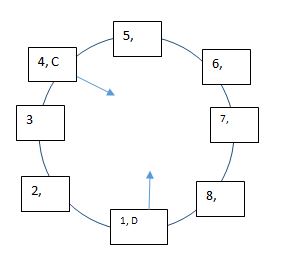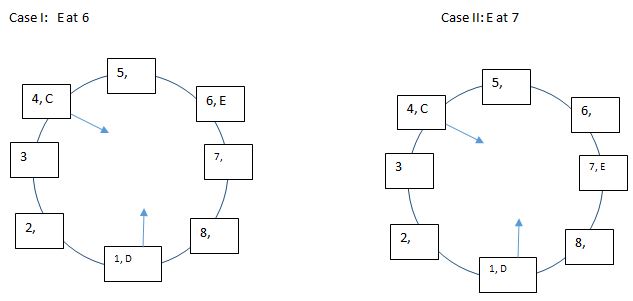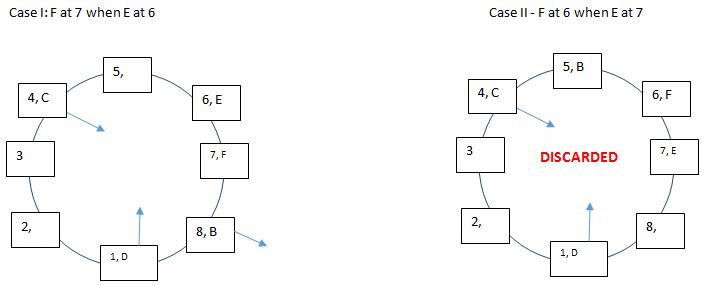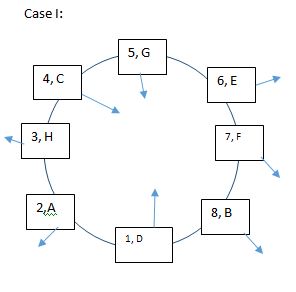Question
Out of the eight friends A, B, C, D, E, F, G and H
sitting around a circular table. How many person faces the centre? I. F is immediate neighbor of E but not the neighbor of A. E is not an immediate neighbor of D or C. Three of them are facing the centre. II. The only one who is sitting in between D and F, is not facing the centre. G is third to the right of A and is facing the centre. C is third to the left of D and both are facing the centre. B is the neighbour of F. III. F is an immediate neighbor of B and facing outside. Each of the questions below consists of a question and three statements numbered I, II and III given below it. You have to decide whether the data provided in the statements are sufficient to answer the question. Read all the three statements and Give answerSolution
From I and II: From II, C is third to the left of D and both are facing the centre.  From I, E is not an immediate neighbor of D or C. E can either be seated at 6 or 7.
From I, E is not an immediate neighbor of D or C. E can either be seated at 6 or 7.  F is an immediate neighbor of E but not of A. And B is the neighbour of F. Thus, in case I, F cannot be seated at 5 because then B cannot be a neighbor of F. Thus F sits at 7 when E sits at 6 and B sits at 8. Similarly, when E is at 7, F cannot be at 8. Thus F sits at 6 when E sits at 7 and B sits at 5. But according to II, The only one who is sitting in between D and F, is not facing the centre. Thus, only person sitting between D and F. Thus, case II discarded.
F is an immediate neighbor of E but not of A. And B is the neighbour of F. Thus, in case I, F cannot be seated at 5 because then B cannot be a neighbor of F. Thus F sits at 7 when E sits at 6 and B sits at 8. Similarly, when E is at 7, F cannot be at 8. Thus F sits at 6 when E sits at 7 and B sits at 5. But according to II, The only one who is sitting in between D and F, is not facing the centre. Thus, only person sitting between D and F. Thus, case II discarded.  G is third to the right of A and is facing the centre. Also, only three people face the center. Thus A is facing outside.
G is third to the right of A and is facing the centre. Also, only three people face the center. Thus A is facing outside. 
What will be the fixed cost for the year for ABC Ltd is it sells 42500 units at Rs.120 each, and its break-even point is 25% of sales with PV ratio of 2...
In a leveraged buyout (LBO), what is the primary source of funds used for the acquisition of a company?
How much did the State Bank of India (SBI) raise through its sixth infrastructure bond issue?
Mr. A is addressing to a the costing technique of his product to Mr. C and says “Here the cost of completing each stage of work is ascertained, like c...
Which type of risk is associated with internal procedures, people, and systems within a company?
What is the role of the board in CEO selection and performance evaluation?
Which bond index India’s Govt bonds are likely to be included this year?
If an individual is unable to pay back the overdraft taken by him it is known as
Which of the following is not likely to be a motivation to overreport earnings?
Which term is the synonyms term to full range of frauds committed by business and government professionals?
Relevant for Exams:


